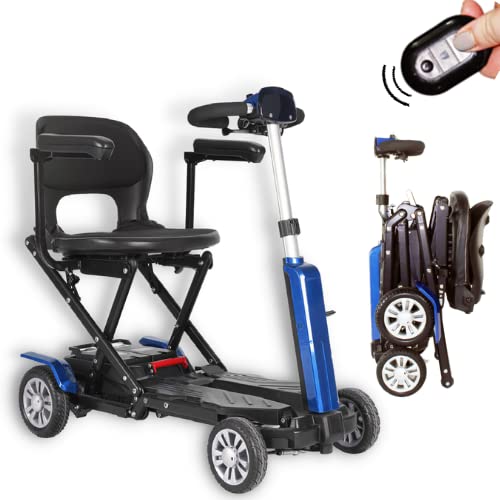Things to Consider When Buying a Mobility Scooter
A mobility scooter can be an investment that can be costly. Fortunately private insurance companies as well as government programs like Medicare typically cover the cost of a scooter if it's medically necessary.
People with mobility issues should be familiarized with the various types of scooters that are available to them. Buyers must first know their own needs and objectives.
What to Consider
When it comes to choosing the right mobility scooter, there are many factors to consider. There isn't any one-size-fits-all mobility scooter. The wrong mobility can cause problems such as a poor fit, a low battery life, or even safety issues.
What will your parent use the scooter for? Do they plan to shop, run errands, or just take it for rides around the neighborhood? If yes, then a lightweight mobility scooter with good battery life is probably the best option. If they intend to travel on rough or bumpy terrain, a four-wheel scooter with larger wheels might be the best option.
Also, take into buy mobility scooter near me that your parent's physical condition could change in the near future, so you will be able to determine if they'll still be able to use their mobility scooter within some months or even years. If not, they might need to consider upgrading their scooter or finding a permanent alternative such as a power wheelchair.
Before deciding on a final choice, you should encourage your child to test out several different mobility scooters. They can test out how comfortable the seat is and determine if they are able to reach the tiller. They should also sit on the driver's side in order to ensure that the scooter fits them and is comfortable.
Ask your local dealer about used scooters. You can also check with rental companies to see whether they have second-hand scooters for auction. It is crucial to confirm the warranty and other information prior to purchasing a used scooter.
Seating
Some customers buy scooters with two seats in the hope of being able transport friends or family members who want to accompany them on their journeys. There could be privacy issues if the people who will be joining you are not of the same weight. This could mean that they will be crashing into each other and creating problems with personal space. If these are issues you are worried about, it is recommended to purchase a seat-behind scooter instead of one that has a rear and front seat.
With a scooter that has two seats, you will not just enjoy the company of a relative or friend and save money by not purchasing two mobility vehicles. You can also reduce wear and tear as well as electricity by using just one scooter to operate and share the cost of fuel.
There are many seating options to choose from when looking for a two-seat mobility scooter. Certain models come with seats for the driver in the front and a passenger seat behind, while others have both seats at the rear. The majority of mid-range and premium scooters come with this setup, however, some may only have a front or rear seat.
Another option is to purchase the scooter with a powered lift, which permits you to effortlessly take the scooter inside and out of your vehicle. This can help you save time and effort when it comes to planning your trip, since all you have to do is direct the scooter to the lift platform and then turn on the switch. After that, you can leave and when you're ready to return, turn back the procedure.
Wheels
The wheels on mobility scooters are a crucial component of the vehicle, and they can affect your riding experience. Tires that are in good condition will provide a comfortable and smooth ride. Tires that are damaged or old can be dangerous. You should check your tires frequently and replace them when they get worn out.
There are three kinds of scooter tires: pneumatic, foam-filled, and solid. Solid and foam-filled tires are never flat however they are more difficult to maneuver than pneumatic tires. Most portable and travel scooters have filled with foam or solid tires, whereas the majority of all-terrain and full-size scooters use pneumatic tires.
Pneumatic tires have an inner tube that's air-filled, similar to the motorbike or bicycle tire. They're the most popular type of scooter tire, and they're easily repaired.
There are also tires with liners that fit between the tire's outer and inner tube, providing added protection against punctures. The owner's manual will tell you the recommended tire pressure. Tires will last longer if they are inflated to this pressure.

The majority of scooters are controlled via tillers which are T-shaped columns that rotate the front wheels to either the left or right. Other controls such as turning and speed indicators can be on the tiller, too. Some tillers come with wraparound handles, called delta tillers, which are perfect for those with limited hand dexterity or strength.
Batteries
Having the right type of battery in your scooter is very important. The right battery can prolong the lifespan of your scooter. It is important to keep in mind that batteries may lose performance as they age. If you notice that your battery isn't able to hold charge as well as it used to, it could be a sign it is in need of replacement.
If you'd like to ensure your battery lasts for a long time, then it is worth investing in a gel battery or an AGM battery. These batteries come with an immobile electrolytes and are airtight making them more resistant to jostling. They also have a much longer lifespan than other batteries. They're a little more expensive upfront but their long-term value makes them worth it.
A lithium battery is a different option. These are a bit more expensive initially, however they can offer up to 10 times the life span of lead-acid batteries. Additionally, they are suitable for travel in the air and are available with a certificate from the IATA.
When purchasing a scooter battery, it's important to look for the model and brand name of your mobility scooter on the label. Utilizing offbrand or generic batteries can harm your mobility scooter and cause it to function properly. In the same way, if you have an older battery that has been recharged using another charger, it might not perform as well.
Certain scooters require stronger batteries than others, so be sure to check with the manufacturer. They will usually have a list with compatible batteries for their scooters. Ask the seller if they have any documentation of maintenance, in the event that you purchase a used mobility device. These can assist you in determining the age of the battery and whether it was recently serviced.
Safety
A scooter can be lifesaving for people who struggle to walk because of age or illness but only if operated properly. If it's not used correctly, it can cause injury to the user as well as the people who are around them. To avoid this, it's important to know what you should look for in a mobility scooter before making the purchase.
Make sure the scooter comes with an operating manual that contains specific information for your model, including safety guidelines and maintenance schedule. Keep the manual on hand to refer to when using the scooter.
Check the scooter's comfort and see if you are able to operate it easily with both hands. The scooter should be able handle the weight you plan to carry.
Check the ground clearance of the scooter to ensure that it can travel over bumps and other obstacles. Travel/portable models have less clearance than larger scooters, and specialty models may have an even smaller clearance.
Find out the details of the history of repairs and maintenance if you're purchasing a used scooter. These documents can provide valuable information about the condition of the scooter prior to you purchase it.
You should consider purchasing a scooter security device such as a wheel clamp, to deter theft. The device attaches to the wheel of the scooter and can't be removed without tools, so it's a good deterrent for thieves.
It's also a good idea to be familiar with the areas you intend to travel in, especially areas that aren't able to accommodate scooter users. You can avoid certain areas by studying curb cuts and streets without sidewalks.
